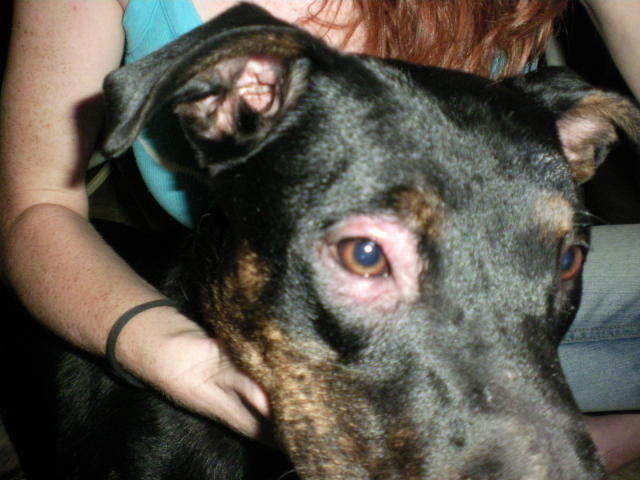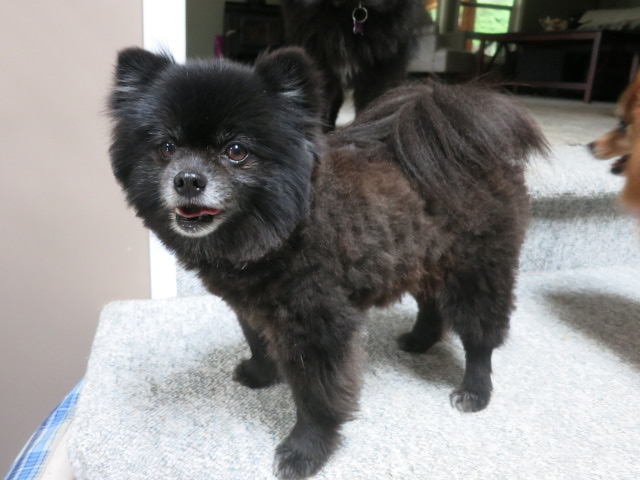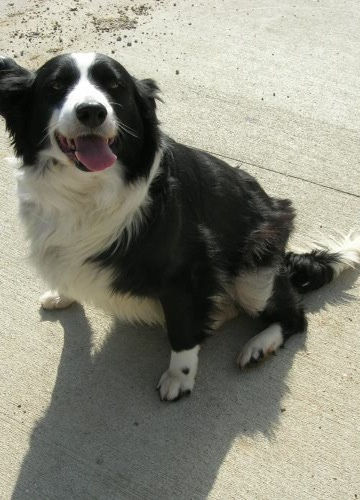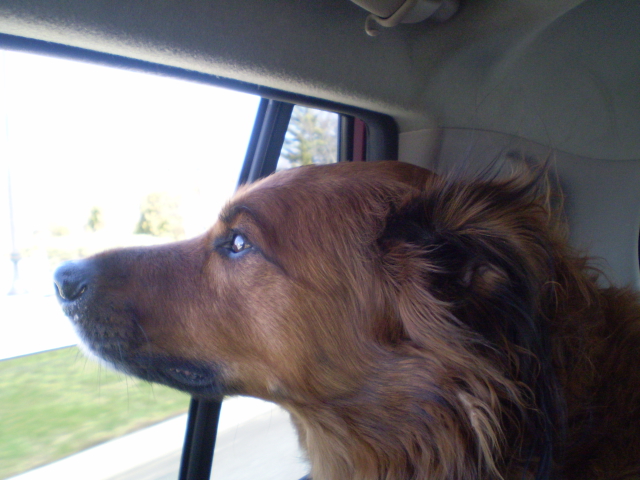QuestionWe have a five year old sheltie and he is wonderful 98% of the time. We only have a problem when the door bell rings; he charges the door and barks viscously. It does not matter who is at the door; he barks no matter who it is. How can we break him of this habit.
AnswerTeach him to do something >>else<< when the doorbell rings. An example would be to train him to go to his crate or bed, or into another room, whenever he hears the doorbell. First, you need to teach him to do whatever you want him to do, on command, without using the doorbell. This is often called a 'place' command. Decide where it is you want him to go when he hears the doorbell, whether it's his crate, his bed, another room, a chair in the living room, or whatever. Then, use treats to teach him to associate your command word/phrase with the place you've chosen. If you do not want to use the word 'place' as the command, you don't have to. You can use whatever word you want to use, but once you start using a word, you have to stick to it, and so does everyone else in the household. You can tell him to 'go to bed' if you want, or to 'settle,' but every single person in the home must use the same word when giving the command later on.
Here's the process:
1. Put the dog on a leash, so that you can help guide him if necessary. He does not have to be wearing a training collar - you can use his regular flat collar for this
2. Have a handful/pocketful of treats that he will go after if you toss them. Walk him over to the crate or his bed (or whatever spot you've decided you want him - for purposes of explanation, I'm going to refer to his bed as this spot from now on). While you're standing directly next to the bed, toss 3-4 treats onto the far corner of the bed and give the command, "Place," as he goes for the treats. If he doesn't go after the treats when you toss them, see if you can get him to follow your hand to them. You may use gentle leash pressure if you need to, and if he does not respond negatively to it by trying to pull away.
As soon as all four feet are on the bed, praise him. Right now, do not worry if he eats the treats and comes right back off the bed. We're not concerned yet with getting him to lay down and stay there - that will come once he understands that the word 'place' means to go to his bed. ;^)
3. Repeat this step several times (no more than 8 times, so he doesn't get bored) in one session. He should pick up on it pretty quickly. You can try again in a few hours if you want, and do several sessions in one day, or just one session a day.
4. The next day, try saying the command >>just before<< tossing the treats, to see if he steps onto the bed when he hears the command, instead of only to go get the treats. Remember to praise him when he does step on the bed on command!! Repeat this step several times, and then start to gradually increase the amount of time between saying the command and tossing the treats by one second, then two seconds, then three, etc.
5. When he will go onto the bed on command when you are standing right next to it, and before you toss the treats, you can start adding distance, because he has made the connection between the word, 'place,' and going on the bed. He should still be on the leash for this. To start this step, let him see you put the treats on the bed. If you can have someone hold his leash, a few feet away from the bed as you put the treats on it, that would really be helpful. After you've put the treats on the bed, go straight over to him, take the leash from your helper, and give the command. If you've done step one correctly, he should go straight to the bed without any help from you (try not to 'hold him back' with the leash - go >>with<< him - again, the leash is only there for guidance if you need it). As soon as he steps on the bed, praise him as he eats the treats. Repeat several times, and gradually add more distance, until he will go to his bed on command from all the way on the other side of the room. Now you can start teaching him to lay down on the bed once he gets there.
6. When he will go to his bed from across the room, when you tell him to 'place,' then that means he has a good understanding of the meaning of the word. You can now start teaching him to lie down on the bed once he gets there. To do this, you will need to begin just as you did in step one, right beside the bed. The only difference is that you are not going to toss treats onto the bed. You're going to only treat him for laying down.
Standing next to the bed, give him the place command, and as soon as all four feet are on the bed, tell him to lie down. If you need to, you may use a treat, held in your hand, to lure him into position, or you may use leash pressure. If he does not yet KNOW the lie down command, you need to teach it separately, away from the bed, first. I have a video on YouTube that shows how to teach a dog to lie down. It is located at http://www.youtube.com/watch?v=3oYR8FnfD64
When he lies down on the bed, calmly praise him (so he doesn't jump back up), and feed him several treats, one at a time, while he's in position. After you give him the last treat, release him with an enthusiastic "Okay!" or "Finished" or even a nonsense word like "Wheee!" When he hears this word, it should mean to him that he is now free to get up and move. Again, if he does not know the meaning of a release word, you will have to teach him. After you say it, toss a toy or treat a few feet away so that he has to break position to get it. Be happy and enthusiastic, and play with him for a minute before repeating the exercise.
Do this exercise several times.
7. When he will go to the bed and lie down on command, you can start eliminating the down command. You want him to go to his bed and lie down whenever he hears the word, 'place.' He may have already started to do this on his own, and he may not. Either way, it's ok. You should still be just a foot or two from the bed. Give him the 'place' command, and watch to see if he lays down on his own when he gets there. If not, do not >>say<< anything, but use a treat to lure him into a down, or use leash pressure. THEN praise him and give him the treat and release him. If you have to 'help' him into position, you should only give him verbal praise and one treat. Give him the succession of treats (along with verbal praise) only if he goes down on his own. He should figure this out really fast, so you can then start adding distance. Step back to between 5 and 7 feet from the bed, and give the place command. Go with him, in case you have to lure him down or use the leash, and remember to praise him calmly as you feed him the several treats one after another while he's in the down position. Then release him.
8. Continue this process until you can tell him from across the room to 'place,' and he will go to his bed and lay down and wait for you to come and give him treats and release him. At this point, start increasing the time he is laying on his bed, as you walk over to treat him, until he will lay there for up to 10 minutes before you go over and treat & release him.
9. At that point, you can start conditioning him to go to the bed and lie down whenever he hears the doorbell. You will need a helper for this, to stand outside and ring the bell. You may want to put a sign out there that says something to the effect of, "Please do NOT ring the doorbell. Knock on the door or call instead. I'm training my dog not to charge the door at the sound of the bell." The reason is because you will not be able to enforce your dog's 'place' command AND answer the door at the same time, at first. If there is someone else home that can answer the door while you stand next to your dog and make sure he remains on the bed, then it shouldn't be that big of an issue, but if you are the only one home, put a sign up, or don't answer the door.
You will need for him to be dragging his leash for this because he is going to be more difficult to control. You should use EXTRA special treats, that he gets at no other time. It helps if they're stinky, so liver treats should work well. You can also use cooked, plain, boneless chicken breast, cut into small cubes.
Have your helper ring the doorbell one time. As soon as the doorbell rings, give your dog the 'place' command. You will have to speak loudly because of the volume and pitch of a Sheltie's bark - you want him to be able to hear you over himself! **laugh** Most likely, he will completely ignore the command and continue barking and charging at the door. Walk calmly over to him, pick up his leash, say "NOOoo" in a firm tone of voice, give the leash a good 'snap,' and then say 'place,' again. Use the leash to tug, tug, tug him towards the bed if he does not 'hear' the command this time. Once you get him there, you may also have to lure him down with a treat, or pull him down with the leash, because he's still going to be excited about hearing the doorbell ring. You're probably going to think that all your work with him teaching him to go to his bed on command was for nothing. I assure you it wasn't. You just have to re-condition him so that the sound of the doorbell replaces the verbal 'place' command. As long as you consistently work with him every day on this, it WILL happen!
At these beginning stages, you should not go to the door once he is laying on his bed. Simply have him lay there for a few minutes until he calms down, and then release and play with him. Then repeat it all again. Do no more than 5 repetitions in a row during each session. You may do as many sessions per day as you can handle, or no more than 4 or 5. **laugh**
9. Soon, your dog should start to respond, even if only somewhat, to your 'place' command at the sound of the doorbell. He may still be barking, but that's okay for now. Encourage him verbally, even if he only takes a few steps towards the bed, so that he knows he's doing what he's supposed to be doing! Continue to use the leash to get him there if he doesn't go all the way on his own, & pet him and calmly praise him while he's laying on the bed. Eventually, he should start going to the bed on his own when the doorbell sounds.
10. When he is going to the bed on his own at the sound of the doorbell, you can start teaching him to stay there as you go to the door to answer it. Again, have your helper stand outside and ring the doorbell once. If your dog doesn't start towards the bed, remind him by saying 'place.' Make sure he gets to the bed and lies down before you even think about going to the door. Once he's lying down on the bed, walk towards the door, but watch him out of the corner of your eye. Be careful not to 'sneak' towards the door - walk normally - just keep an eye on him as you do so. If he gets up, say "NO" in a firm tone of voice and go put him back, using the leash. You may have to do this several times. Don't try opening the door until he will remain on his bed as you are walking to the door. It's extremely, extremely important that you immediately tell him no and go put him back if he gets off the bed, >>even<< if you're actually greeting someone at the door.
Good luck with all of this. I hope it's not too much for you, but in all honesty, if you work with your dog even just once a day, and are consistent, you should be able to get through all the steps in a month or even less

 7 month old blue healer mix (Cloe)
Question
cloes right eye
Cloe was having really bad eye
7 month old blue healer mix (Cloe)
Question
cloes right eye
Cloe was having really bad eye
 Will my Pomeranian loose his hair
Question
My Pomeranian`s hair c
I have a 5 year
Will my Pomeranian loose his hair
Question
My Pomeranian`s hair c
I have a 5 year
 dog who growls and nips
Question
Ladybug
We adopted a rescue dog, Ladybu
dog who growls and nips
Question
Ladybug
We adopted a rescue dog, Ladybu
 aggressive kids and dogs
QuestionI have a hyper aggressive 6 yr old who always p
aggressive kids and dogs
QuestionI have a hyper aggressive 6 yr old who always p
 Puppy wont come
Question
Capone & Rascal
Help! My seven week
Puppy wont come
Question
Capone & Rascal
Help! My seven week